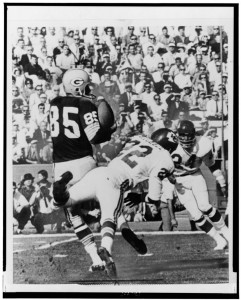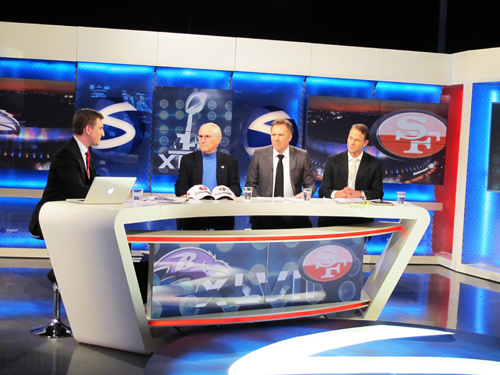How Did The Super Bowl Become Such a Big Deal
Super Bowl Sunday

The Super Bowl is the single most popular event in sports in the United States.
How did the Super Bowl become a cultural phenomenon?
The sport of playing football was relatively new in 1892. It was invented from the combination of two sports, soccer and rugby. On November 6, 1869, the first college football game was played between Rutgers and Princeton. Walter Camp, in 1876, a great rugby player from Yale, modified some rules that changed rugby into more of the American Football we play today. He became known as the father of American football. It immediately became a very competitive sport and each team attempted to have the best players in the games.
The seeds of pro American football began with amateur athletic clubs, who eventually secretly recruited the better college football players to join their teams.
The players were supposed to be amateurs and therefore receive no compensation, making it illegal to pay a football player.
The History of Professional American Football
There were two particular teams who were heated rivals. The Allegheny football team was started in 1890, and the Pittsburgh team, which was started in 1891. Accusations and controversy ensued about the Pittsburgh coach who was paid for his work, but also was a player. The Allegheny football team believed this made him a professional football player.
The true history of pro football in America can be documented` back on November 12, 1892. The football team called the Allegheny Athletic Association won over the Pittsburgh Athletic Club. Although the game itself was not momentous, sports history was made.
It was William (Pudge) Heffelfinger who made this game historic. He was one of the Allegheny Athletic Association players and it was the first time in history that that there was written proof from an expense sheet that showed a player was paid to play football. He was paid $500 to play the game. The document was not found until 80 years later, but nevertheless, it offered the first proof that went against the standard practice of not paying a player. This document is referred to as "pro football's birth certificate." The Football Hall of Fame has this document on display in Canton, Ohio.
No one knew back then that how football would one day become a defining force for so many people who enjoy the game, the football parties, the advertising, the betting on the football games, the social connections and the economic benefits the Super Bowl brings to so many Americans each year. The influence the Super Bowl has on the U.S. economy, the amount of money corporations spend on advertising to promote their products, and the salaries and fame the players achieve, make for many defining moments with annual sporting extravaganza.
In 1893, the Pittsburgh Athletic Club signed (it is believed to be) Grant Dibert, a halfback to the first pro football contract for all the games played for the year. In 1897, the entire team of the Latrobe Athletic Association became the first team to have all of its players be paid professionals.
In 1899, a neighborhood team called the Morgan Athletic Club in Chicago, later became the Chicago Cardinals and then moved to St. Louis, and in 1994, moved to Arizona and became the Arizona Cardinals, making this team the oldest continuing operating pro football team in history. In 1900, William C. Temple became the first known individual club lowner of a professional football team. The team was called the Duquesne Country and Athletic Club. The first attempt at a football league was in 1902, when Connie Mack from Philadelphia formed three professional teams and called them the National Football League.
The History of the Super Bowl

Pro Football in the United States
By 1920, professional football had players jumping from one team to another based on the highest offers paid.They were using college players who were still enrolled in school, and no two teams in league followed the same rules. An organizing committee in Canton, Ohio was formed to set up rules that all members would follow.
On August 20 the American Professional Football Conference was created. Another meeting was held on September 17 and the league name was changed to the American Professional Football Association and James Thorpe, a famous football player at the time was elected president.
On June 24, 1922, the name was changed to the National Football League, with 18 teams being part of the league. In 1925, five new teams were added to the NFL. Throughout the years teams entered the league and then folded or moved. Many teams were based in small towns and drafted players from their within their community. They worked during the day and played on weekends. They had jobs during the offseason and the teams had sponsors, similar to the little leagues of today. The NFL grew from an unsophisticated beginning and transformed over the decades into a powerhouse entertainment, marketing, and sports entity.
Super Bowl Poll
Do You Watch the Superbowl
The Highest Paid Players in Pro Football
The Pro Football Hall of Fame, which opened in 1963 made its home in Canton, Ohio to honor the birthplace of professional football.
For years, Brallier was considered to be first American professional football player
Listed below are the first seven players known to have been openly paid to play football:
William "Pudge" Heffelfinger – Allegheny Athletic Association, Pittsburgh, – $500 for one game on November 12, 1892.
Ben "Sport" Donnelly – Allegheny Athletic Association, Pittsburgh – $250 for one game on November 19, 1892.
Peter Wright – Allegheny Athletic Association, Pittsburgh – $50 per game (under contract) for the entire 1893 season.
James Van Cleve – Allegheny Athletic Association, Pittsburgh – $50 per game (under contract) for the entire 1893 season.
Oliver W. Rafferty – Allegheny Athletic Association, Pittsburgh – $50 per game (under contract) for the entire 1893 season.
Lawson Fiscus – Greenburg, PA – $20 per game (under contract) for the entire 1894 season.
John Brallier – Latrobe, PA, – $10 and expenses for one game on September 3, 1895.
The First Super Bowl
The popularity of the Super Bowl came about due in large part to a very smart marketing strategy that has capitalized on many appealing factors to viewers. Every business involved in the Super Bowl stands to gain greater profits from the popularity of this annual event. The Super Bowl over the decades, captured the attention of most of America by marketing to women, through the joint efforts of their media partners, and the connection football makes with patriotism.
In 1967, when the first Super Bowl was held, the hosting Los Angeles stadium was only little more than half filled. At the time CBS televised NFL games and NBS televised AFL games. Both networks televised the first Super Bowl. The cost of tickets ranged from $8 in the nosebleed section, to $12 for the best seats.
Less than 62,000 people attended in the game at the LA Coliseum in a stadium that could accommodate nearly 100,000. However, more than 65 million viewers watched their televisions, and set a record for a larger television audience than any other sporting event that was previously broadcasted. The networks sold a 30 second ad for $42,500, In comparing 2007 dollars $262,000. An ad in 2007 sold for $2.6 million. The viewership revealed the great potential this game would have in the future. The January 1969 pitted the New York Jets against The Baltimore Colts. The Colts were the favored team to win.With many people believing it would be another NFL dominated win, this Super Bowl holds the record for the lowest television ratings of any Super Bowl. The Jets won 16 to 7, and it was the first time an AFL team won the Super Bowl. This exciting game made people take more notice and helped hype up future games and lead fans to believe their team may one day get to the Super Bowl and even become champions.
Super Bowl Hype

The Popularity of the Super Bowl
The Super Bowl is different from other sports team championships mainly because all other sports decide their big winners over several games. The Super Bowl is a one day event, and the Jets proved anything can happen in this one day and one game. The Super Bowl has turned into a must see event. In 1970 the two leagues merged into the NFL, with two conferences, NFC, and AFC. By 1973 corporations started marketing themselves through memorable ads shown during the Super Bowl.
By the late 1970’s, the Super Bowl was the most watched tv program of the year. In 1982 Diana Ross sang the national anthem prior to the start of the game, and she captivated the television audience. Prior Super Bowl games mainly featured unknown musicians and college marching bands during the pregame and half time shows. Since then, famous and legendary figures have headlined the entertainment at each Super Bowl.
In 2004, the famous “wardrobe malfunction” with Justin Timberlake and Janet Jackson created a lot of hype when she ended up baring one of her breasts. More than 200,00 people complained and the FCC (Federal Communications Commission) fined Viacom for violating decency standards. In 2005, Congress put a law into effect to increase fines for television nudity. All of this publicity brought even more attention to the Super Bowl. The half time entertainment has not brought in the viewership as well as the advertisements have. By 1984,
Best Super Bowl Commercials
The Super Bowl Ads
Super Bowl ads began to become more talked about, when Apple Computer showed a memorable commercial that introduced the MacIntosh Computer. The ad was all about selling its image and was named Commercial of the Decade by Advertising Age Magazine. TV Guide called it the number one “greatest commercial of all time”. The commercial was only aired that one time during the Super Bowl. This started a trend that led companies to produce high concept, big budget ads that they hoped would pay off to the huge number of television viewers, and a new era of Super Bowl advertising was born.
Each year more imaginative and memorable ads are attempted to be created. 36% of people watching the Super Bowl say they watch the game mainly to see the commercials. Today, ads are shown ahead of the game, as part of the their news stories in the days leading up to the Super Bowl. This extra publicity inspires corporations to pay millions of dollars for a Super Bowl ad.
Super Bowl Sunday
Super Bowl Sunday is now a national phenomenon. With pre game shows, and the hype about the upcoming commercials, the big game has become a cultural event. In 2007, there was more than $2.2 million in flat screen HDTV television sales.
Super Bowl Sunday inspires more sales of beer, soda, chips, and salsa than any other day. In response, Frito-Lay, the largest U.S. maker of potato chips and tortilla chips, produces 10 million more pounds of its snacks in the weeks prior to the Super Bowl. Tortilla chip sales increase 30% during this time. It is Domino Pizza’s biggest delivery day of the year. Restaurants are unusually slow on Super Bowl Sunday due to the large number of house parties and people who stay home to enjoy the game and commercials.
The popularity of the Super Bowl makes this event an almost universally shared experience, among all genders, races, religions, and ages. This is in itself makes the Super Bowl a wonderful event.
More Football Articles by ToKnowInfo
Super Bowl Party Ideas: Super Bowl Money Saving Ideas
How Super Bowl Footballs are Made
Football Fables, Fairy Tales, and Facts
Football Trivia and Super Bowl Facts






